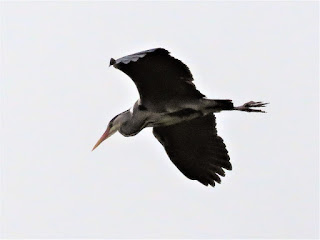Looking NW across some of the pools at the incoming bad weather.
A drake Teal. The light making the green on the head glossing blue.
And here is he is again.
The most elegant and charismatic of all the ducks – a drake Pintail showing why it has that name.
The drake Pintail synchronised diving team.
Again.
Not so synchronised!
And the whole bird.
Again.
Two drakes. I couldn’t find any duck Pintail close-by.
This Grey Heron was rather clumsily descending in to the heronry after seeing off a passing Buzzard.
Here we see one alongside a drake Teal.
Another gull species seen more frequently these days is sleeping here. It is a Mediterranean Gull. Larger than the accompanying Black-headed Gulls. As an adult it lacks any black in the wings. The head is more extensively black and is really black rather than the chocolate hood of Black-headed Gull. Indeed its scientific name Larus melancephalus translates as ‘black headed gull’. The scientific name for Black-headed Gull is Larus ridibundus which translates as ‘laughing gull’. The confusion between vernacular and scientific names continues because there is a Laughing Gull which is a rare vagrant from North America whose scientific name is Larus atricilla which translates as ‘black-tailed gull’. Then there is a Black-tailed Gull (Larus crassirotris = thick-billed gull) in Asia .....
(Ed Wilson)















